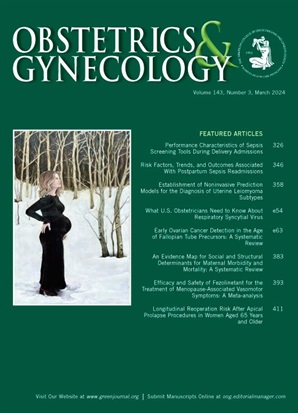感染导致的妊娠相关死亡:2012-2019年妊娠死亡率监测系统。
IF 4.7
2区 医学
Q1 OBSTETRICS & GYNECOLOGY
引用次数: 0
摘要
自1987年开始报告以来,感染一直是疾病控制和预防中心妊娠死亡率监测系统中与妊娠相关的死亡的主要原因。在这项描述性研究中,我们使用了来自妊娠死亡率监测系统的2012-2019年数据。根据社会人口学特征分析感染死亡的具体亚分类,并计算每个感染亚分类的妊娠相关死亡率(每10万活产妊娠相关死亡率)。与妊娠有关的感染总死亡率为2.23。脓毒症是妊娠相关感染死亡中最常见的亚型(46.4%),其次是其他非盆腔感染(25.2%)。在2012年(0.10)至2019年(0.56)期间,心内膜炎导致的妊娠相关死亡率相对增幅最大。报告与妊娠有关的感染死亡的亚分类可以提高集中干预措施以减少与妊娠有关的死亡和评估长期进展的能力。本文章由计算机程序翻译,如有差异,请以英文原文为准。
Pregnancy-Related Deaths Due to Infection: Pregnancy Mortality Surveillance System, 2012-2019.
Infection has been a leading cause of pregnancy-related death in the Centers for Disease Control and Prevention's Pregnancy Mortality Surveillance System since 1987, when reporting began. For this descriptive study, we used 2012-2019 data from the Pregnancy Mortality Surveillance System. Specific subclassifications of infection deaths were analyzed by sociodemographic characteristics, and pregnancy-related mortality ratios (pregnancy-related deaths per 100,000 live births) were calculated for each infection subclassification. The overall pregnancy-related mortality ratio for infection was 2.23. Sepsis was the most frequent subclassification (46.4%) of pregnancy-related infection deaths, followed by other nonpelvic infections (25.2%). Endocarditis deaths had the largest relative increase in pregnancy-related mortality ratio among pregnancy-related infection deaths between 2012 (0.10) and 2019 (0.56). Reporting subclassifications of pregnancy-related infection deaths could improve the ability to focus interventions for reducing pregnancy-related deaths and assessing progress over time.
求助全文
通过发布文献求助,成功后即可免费获取论文全文。
去求助
来源期刊

Obstetrics and gynecology
医学-妇产科学
CiteScore
11.10
自引率
4.20%
发文量
867
审稿时长
1 months
期刊介绍:
"Obstetrics & Gynecology," affectionately known as "The Green Journal," is the official publication of the American College of Obstetricians and Gynecologists (ACOG). Since its inception in 1953, the journal has been dedicated to advancing the clinical practice of obstetrics and gynecology, as well as related fields. The journal's mission is to promote excellence in these areas by publishing a diverse range of articles that cover translational and clinical topics.
"Obstetrics & Gynecology" provides a platform for the dissemination of evidence-based research, clinical guidelines, and expert opinions that are essential for the continuous improvement of women's health care. The journal's content is designed to inform and educate obstetricians, gynecologists, and other healthcare professionals, ensuring that they stay abreast of the latest developments and best practices in their field.
 求助内容:
求助内容: 应助结果提醒方式:
应助结果提醒方式:


